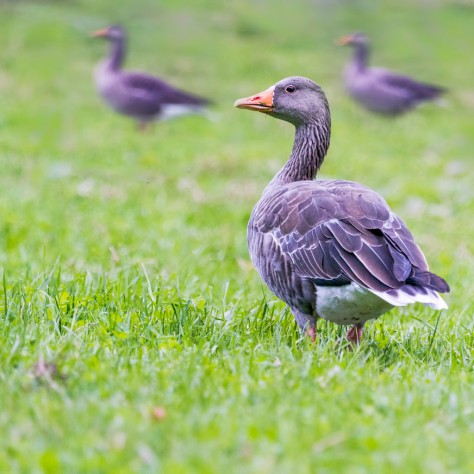
Happy Wild Bird Wednesday :0)
Click the link below to see photographs from many talented folk around the world and feast your eyes on our fine feathered friends!!
The Greylag Goose (Anser anser) is believed to be the ancestor of most modern day domestic Geese. It is the largest of the native UK and European native Geese and, to my eye, it is very similar in size to a Canada Goose (Branta canadensis).
This beautiful bird is officially classed as amber status in the UK, meaning moderate cause for concern for the population numbers.
In the South of England release of birds has been on going for a number of years to help re-establish their population with some success, but the population found in Scotland are from the original native stock and retain more of the natural behaviors of true wild birds.
This was taken on the Isle of Mull, the second largest of the “Inner Hebrides” off the West Coast of Scotland.
Another first for me on a really rather wonderful trip to magical Mull :0)
Shot with the my trusty Canon 100-400mm f/4.8-5.6 L lens wide open on the Canon 7D to get the shallow depth of field to give the soft focus bokeh of the 2 Geese in the background



Superb depth of field !
I have decided to start calling you ‘James’ – am I allowed to do that ?
LikeLiked by 1 person
Absolutely! I am sure we know each other well enough for first name terms ;-). I rather like M-R and shall stick with that if you have no objection. PS Your book is making my commute very much more pleasurable!
LikeLiked by 1 person
You are a gentleman, sir …
LikeLiked by 1 person
I didn’t realise it was amber status. I have always regarded Greylags as ten a penny. I shall treat them with more respect in future.
LikeLiked by 1 person
Sad but true, Andrew and this was my first encounter with these elegant Birds. I think they are going the way of the Starlings which now have a Red Status and are now seldom seen 😦
LikeLike
Nice pictures – I miss my winter trips to the coast of Northumbria and the Solway to watch geese. But parrots do help overcome this!
Cheers – Stewart M – Melbourne
LikeLiked by 1 person
I would trade it in a heartbeat Stewart 😉 Busy saving up for another trip to Australia!
LikeLike
Beautiful photos. Much more interesting than their domestic cousins. I read in the comments that starlings are not common? That’s surprising. They are everywhere here in the US where they are not a native species.
LikeLike
Many thanks Jennifer. Starlings are not yet a real rarity in the UK, but their numbers are dwindling at an alarming rate, (faster than any other species I believe). When I was growing up they reached near plague proportions and the enormous flocks (murmurations) were a common sight. They are now seen mostly as single birds and not too often. They have been assigned Red status more for the concern about their future than for their current numbers:
Here is how our RSPB defines the Red status:
Red is the highest conservation priority, with species needing urgent action. Amber is the next most critical group, followed by green.
Red list criteria
• Globally threatened
• Historical population decline in UK during 1800–1995
• Severe (at least 50%) decline in UK breeding population over last 25 years, or longer-term period (the entire period used for assessments since the first BoCC review, starting in 1969).
• Severe (at least 50%) contraction of UK breeding range over last 25 years, or the longer-term period
Lovely birds and fingers crossed for their future 😦
LikeLike
looks like some superb specimens there ….
LikeLike
Thanks Veronica – they really are superb lookiong birds
LikeLike
An ancestor goose! I love this. Thanks so much for posting the photo and information.
LikeLike
Thank you Marie. It is fascinating to see how little thay have changed in general appearance and a joy to see them in the wild!
LikeLike
Reblogged this on conephotofinearttogo and commented:
I always enjoy this wonderful wildlife photography blog!
LikeLike
Many thanks for the Reblog Lee. Really appreciate it :0)
LikeLike
Have NEVER seen geese that color!! Amazing.
LikeLike
Thanks. They are very distinctive and the original goose colour!
LikeLike
Just showed my 2nd grader the geese. =) Thanks for the follow, Bennett. Happy new year.
Diana
LikeLiked by 1 person
Glad to hear it Diana. Happy New Year to you :0)
LikeLike